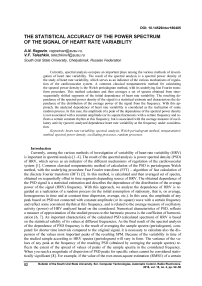The statistical accuracy of the power spectrum of the signal of heart rate variability
Автор: Ragozin A.N., Telezhkin V.F.
Рубрика: Инфокоммуникационные технологии и системы
Статья в выпуске: 4 т.18, 2018 года.
Бесплатный доступ
Currently, spectral analysis occupies an important place among the various methods of investigation of heart rate variability. The result of the spectral analysis is a spectral power density of the study of heart rate variability, which serves as an indicator of the various mechanisms of regulation of the cardiovascular system. A common classical nonparametric method for calculating the spectral power density is the Welch periodogram method, with its underlying fast Fourier transform procedure. This method calculates and then averages a set of spectra obtained from time-sequentially shifted segments of the initial dependence of heart rate variability. The resulting dependence of the spectral power density of the signal is a statistical estimate and characterizes the dependence of the distribution of the average power of the signal from the frequency. With this approach, the analyzed dependence of heart rate variability is considered as the realization of some random process. In this case, the amplitude of a peak of the dependence of the spectral power density is not associated with a constant amplitude (or its square) harmonics with a certain frequency and reflects a certain constant rhythm at this frequency, but is associated with the average measure of oscillatory activity (power) analyzed dependence heart rate variability at the frequency under consideration.
Heart rate variability, spectral analysis, welch periodogram method, nonparametric method, spectral power density, oscillating processes, random processes
Короткий адрес: https://sciup.org/147232220
IDR: 147232220 | DOI: 10.14529/ctcr180405
Список литературы The statistical accuracy of the power spectrum of the signal of heart rate variability
- Рябыкина, Г.В. Вариабельность ритма сердца / Г.В. Рябыкина, А.В. Соболев. - М.: Стар'Ко, 1998. - 240 с.
- Хаютин, В.М. Спектральный анализ колебаний частоты сердцебиений: физиологические основы и осложняющие его явления / В.М. Хаютин, Е.В. Лукошкова // Российский физиологический журнал им. И.Н. Сеченова. - 1999. - Т. 85, № 7. - С. 893-909.
- Зулкарнеев, Р.Х. Клиническое значение исследования вариабельности сердечного ритма / Р.Х. Зулкарнеев, С.А. Каликова // Здравоохранение Башкортостана. - 1998. - № 2-3. - С. 28-36.
- I Всероссийский симпозиум «Колебательные процессы гемодинамики. Пульсация и флюктуация сердечно-сосудистой системы»: сб. науч. тр. 30 мая - 1июня 2000 г. - Миасс, 2000. - 340 с.
- Марпл-мл., С.Л. Цифровой спектральный анализ и его приложения / С.Л. Марпл-мл. - М.: Мир,1990. - 680 с.
- Рагозин, А.Н. Анализ спектральной структуры нестационарных физиологических сигналов на плоскости комплексных частот / А.Н. Рагозин // Цифровые радиоэлектронные системы (электронный журнал). - 1999. - Вып. 3. - С. 34-44. - http://www.prima.susu.ac.ru/drs/.
- Спектральная оценка вегетативного тонуса учащихся средней школы / А.Н. Рагозин, А.М. Усынин, О.В. Токарчук, Д.Ю. Кононов // Цифровые радиоэлектронные системы (электронный журнал). - 1999. - Вып. 3. - С. 127-130. - http://www.prima.susu.ac.ru/drs/.
- Бендат, Дж. Прикладной анализ случайных данных / Дж. Бендат, А. Пирсол. - М.: Мир, 1989. - 540 с.
- Компьютерная программа для спектрального анализа физиологических сигналов (версия 1.0) / А.Н. Рагозин, Д.Ю. Кононов, А.Н. Усынин, М.В. Михайлов // Цифровые радиоэлектронные системы (электронный журнал). - 2000. - Вып. 4. - С. 44-52. - http://www.prima.susu.ac.ru/drs/.


